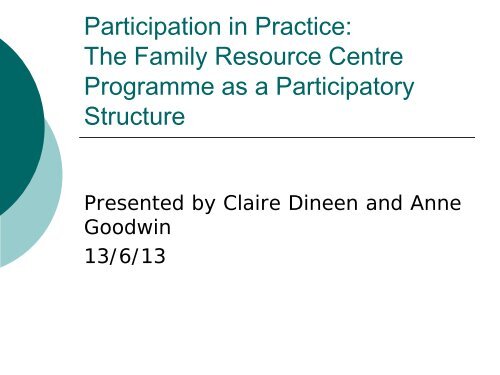Participation in Practice - UNESCO Child and Family Research Centre
Participation in Practice - UNESCO Child and Family Research Centre Participation in Practice - UNESCO Child and Family Research Centre
Participation in Practice:The Family Resource CentreProgramme as a ParticipatoryStructurePresented by Claire Dineen and AnneGoodwin13/6/13
- Page 2 and 3: Overview of the Family ResourceCent
- Page 4 and 5: The Model of Family Support◦ Comm
- Page 6 and 7: Exercise◦ Question AWhat are the
- Page 8 and 9: Barriers to Participation◦ Substi
<strong>Participation</strong> <strong>in</strong> <strong>Practice</strong>:The <strong>Family</strong> Resource <strong>Centre</strong>Programme as a ParticipatoryStructurePresented by Claire D<strong>in</strong>een <strong>and</strong> AnneGoodw<strong>in</strong>13/6/13
Overview of the <strong>Family</strong> Resource<strong>Centre</strong> Programme◦ 106 FRCs nationwide – Irel<strong>and</strong>’s largestcommunity-based family supportprogramme◦ Funded by the <strong>Family</strong> Support Agency◦ Aim: to combat disadvantage <strong>and</strong>improve the function<strong>in</strong>g of the family. Interms of participation the Programmeemphasises the <strong>in</strong>volvement of thecommunity <strong>in</strong> tackl<strong>in</strong>g the problems theyface, <strong>and</strong> creat<strong>in</strong>g successful partnershipsbetween voluntary <strong>and</strong> statutory agenciesat community level.
Functions of an FRCEstablish<strong>in</strong>gnew groupsEnhancecontact <strong>and</strong>participationProvid<strong>in</strong>g<strong>in</strong>formationresourcesInfluenc<strong>in</strong>gPolicyBuild<strong>in</strong>gpartnerships<strong>and</strong>network<strong>in</strong>g &Integration ofServicesCORE FUNCTIONSOF AFAMILY RESOURCE CENTREPromot<strong>in</strong>g selfreliance <strong>and</strong>autonomy (help<strong>in</strong>gexist<strong>in</strong>g groups)ProgressionEducation/Tra<strong>in</strong><strong>in</strong>gSupport:-Self developmentparent<strong>in</strong>g
The Model of <strong>Family</strong> Support◦ Community-based◦ Strengths-based◦ Needs-led◦ Builds resilience <strong>and</strong> capacity◦ Develops connections <strong>and</strong> nurtures asense of belong<strong>in</strong>g◦ Promotes social <strong>in</strong>clusion◦ Strengthens formal <strong>and</strong> <strong>in</strong>formal supportnetworks◦ Works <strong>in</strong> partnership <strong>and</strong> strives form<strong>in</strong>imum <strong>in</strong>tervention
Case Studies◦ Case Study 1: Kate’s Story- demonstrates the<strong>in</strong>volvement of a whole family <strong>in</strong> the FRC◦ Case Study 2: Mary’s Story- highlights the impactof community participation <strong>in</strong> response to a localtragedy◦ Case Study 3: John’s Story- focuses on a youngman’s progression for youth club participant tocompany director
Exercise◦ Question AWhat are the factors which facilitateparticipation?◦ Question BWhat are the factors which h<strong>in</strong>derparticipation?
Facilitat<strong>in</strong>g Factors with<strong>in</strong> the FRCProgramme◦ Universal service provision◦ ‘Open door’ access◦ Partnership approach◦ Collaborative work<strong>in</strong>g methods◦ Multi/<strong>in</strong>ter <strong>and</strong> trans discipl<strong>in</strong>ary approach lead<strong>in</strong>gto enhanced responsiveness◦ The application of an ecological underst<strong>and</strong><strong>in</strong>g◦ Self-referral/multi-referral pathways◦ Voluntary participation◦ Consultative process result<strong>in</strong>g <strong>in</strong> more focusedservice delivery <strong>and</strong> greater engagement◦ Relationship-based practice
Barriers to <strong>Participation</strong>◦ Substitution of consultation forparticipation◦ Fear of los<strong>in</strong>g power◦ Lack of staff tra<strong>in</strong><strong>in</strong>g◦ Lack of time to develop the process <strong>and</strong>build relationships◦ Lack of resources◦ Lack of commitment
Thank You



